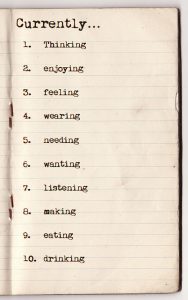If you’re like most people, you get a great feeling from opening a brand new notebook. As you look at all those blank pages the question becomes: “What should you do with it?” There are so many things you can do with a notebook!

Many people have a notebook obsession. I know I do.
A blank notebook is full of promise. It’s an opportunity to reflect, to create, and to express yourself. When looking at a blank notebook it’s almost impossible to resist the temptation to grab a pen and begin filling its pages.
 Although any notebook will do, many people swear by Moleskine notebooks– a brand of notebook produced by Milan-based company Modo & Modo. Moleskine notebooks are high quality; they’re portable, so you can carry them around with you; and they have a pouch for storage. In addition, the pages have a nice texture—great to the touch—and there’s little bleed through if you use a pen.
Although any notebook will do, many people swear by Moleskine notebooks– a brand of notebook produced by Milan-based company Modo & Modo. Moleskine notebooks are high quality; they’re portable, so you can carry them around with you; and they have a pouch for storage. In addition, the pages have a nice texture—great to the touch—and there’s little bleed through if you use a pen.
Here, then, are 18 things to do with a Moleskine, or whatever notebook suits your fancy:
 1. Keep a Food and Exercise Journal. Lots of people have life goals related to fitness and wellness. The two major pillars of fitness and wellness are what you eat, and how much exercise you get. Use your notebook to keep a food and exercise journal.
1. Keep a Food and Exercise Journal. Lots of people have life goals related to fitness and wellness. The two major pillars of fitness and wellness are what you eat, and how much exercise you get. Use your notebook to keep a food and exercise journal.
Create a template to keep track of the food that you eat. Across the top of the page write the following: Date; Time; Item; Portion Size (Amount); Nutrients; and Calories.
In addition, create another template to keep track of how much exercise you’re getting and how many calories you’re burning. Across the top of the page write the following: Date; Time, Activity, Duration; and Calories Burned.
 2. Keep Track of Your Time. You can use an empty notebook in order to start keeping track of your time. Find out once and for all where your time goes. In addition, keep track of the following:
2. Keep Track of Your Time. You can use an empty notebook in order to start keeping track of your time. Find out once and for all where your time goes. In addition, keep track of the following:
- How much time are you losing to procrastination?
- How do you deal with interruptions?
- Do you work on one thing at a time, or do you multitask?
- How much time do you spend working on your important life goals?
- How much time do you waste on “busy work” or unimportant tasks?
 3. Keep Track of Your Expenses. A good use for a blank notebook is to start keeping track of where your money goes. Keep track of the following:
3. Keep Track of Your Expenses. A good use for a blank notebook is to start keeping track of where your money goes. Keep track of the following:
- Do you spend your money on frivolous expenses?
- What do you need to cut back on?
- Are you investing your money—investing in your education, investing in income producing assets, and investing in creating memories you’ll always cherish—or are you wasting it?
 4. Start a One Sentence Journal. If you’re short on time—or writing just isn’t your thing—try keeping a one sentence journal. Every day write down one sentence about that day. It can be something like the following:
4. Start a One Sentence Journal. If you’re short on time—or writing just isn’t your thing—try keeping a one sentence journal. Every day write down one sentence about that day. It can be something like the following:
- It was a good day today.
- A man talking on his cell phone almost hit me with his car; I saw my life flash before my eyes.
- I finally finished my novel today!
If you do this every day for five years, at the end of that time you’ll have a five-year time capsule in your notebook
 5. Keep a Gratitude Journal. You’ve heard this over and over again: the key to happiness is to keep your attention focused on the good in your life. And one way to make sure that you’re doing this is by keeping a gratitude journal.
5. Keep a Gratitude Journal. You’ve heard this over and over again: the key to happiness is to keep your attention focused on the good in your life. And one way to make sure that you’re doing this is by keeping a gratitude journal.
Studies conducted by psychologists have traced many benefits to the practice of writing down the things that you’re grateful for on a regular basis. The simplest way to keep a gratitude journal is to sit down with your notebook each night for a few minutes and write down five things that you’re grateful for.
 6. Write Morning Pages. Morning pages—which consist of exploratory writing–were made famous by Julia Cameron in her book, “The Artist’s Way”. The idea is to sit down each morning and write three pages in long hand. Simply write down anything that comes to mind for three pages and then stop.
6. Write Morning Pages. Morning pages—which consist of exploratory writing–were made famous by Julia Cameron in her book, “The Artist’s Way”. The idea is to sit down each morning and write three pages in long hand. Simply write down anything that comes to mind for three pages and then stop.
Use your morning pages to work out issues that are bothering you, to plan your day, and to get in touch with your authentic desires (what you really want, as opposed to what society says you should want).
 7. Record Your Life Story. Gather a list of life prompts that inspire you to reflect on your life so that you can start recording your memories. Then, use your notebook to write your life story.
7. Record Your Life Story. Gather a list of life prompts that inspire you to reflect on your life so that you can start recording your memories. Then, use your notebook to write your life story.
Life prompts can include questions such as the following: What’s the meaning behind your family name? What are some of the stories your grandfather used to tell you when you were a kid? What are your favorite summer memories?
My eBook, “Create Your Life Story”, contains 444 memory prompts, covering several life areas, to help you get started recording your memories and writing your life story.
 8. Keep Track of Your Life Audits. In a previous blog post I encouraged you to begin auditing different areas of your life on a regular basis in order to keep improving and moving forward. You can use your notebook to keep track of your life audits.
8. Keep Track of Your Life Audits. In a previous blog post I encouraged you to begin auditing different areas of your life on a regular basis in order to keep improving and moving forward. You can use your notebook to keep track of your life audits.
For example, if you’re conducting an energy audit you can use your notebook to keep track of your energy levels throughout the day. Do you feel depleted after talking to certain people? Does eating an apple in the afternoon make your energy levels rise? How do you feel after taking a nap?
 9. Copy Leonardo da Vinci’s Notebook Habit. Leonardo da Vinci developed the habit of always taking a notebook with him wherever he went. He would use his notebooks to sketch people, birds, or objects he saw during his walks, and to write down ideas and observations. The simple act of writing down his ideas allowed Leonardo to dwell on them and to improve them over time.
9. Copy Leonardo da Vinci’s Notebook Habit. Leonardo da Vinci developed the habit of always taking a notebook with him wherever he went. He would use his notebooks to sketch people, birds, or objects he saw during his walks, and to write down ideas and observations. The simple act of writing down his ideas allowed Leonardo to dwell on them and to improve them over time.
You can use your notebook to write down any of the following: potential names for characters in your novel; the name of a new color you just discovered; interesting conversations you overhear; capture ideas for blog posts; jot down poems you come up with; record recipes you want to try; or just to capture random thoughts and insights.
 10. Write Down Quotes You Love. It’s great to sit back with a great collection of quotes and just soak in their wisdom. Start jotting down quotes you love and soon you’ll have a notebook filled with inspirational sayings which can serve to lift your spirits at a moment’s notice. You can get started with these quotes:
10. Write Down Quotes You Love. It’s great to sit back with a great collection of quotes and just soak in their wisdom. Start jotting down quotes you love and soon you’ll have a notebook filled with inspirational sayings which can serve to lift your spirits at a moment’s notice. You can get started with these quotes:
 11. Keep a Journal. A journal is a description of your day. It also contains your feelings and reflections about the things that happened to you throughout the day. A lot of people keep a jar filled with journal prompts to help inspire them to write in their journals. A journal jar is simply a mason jar—or any jar you have lying around—filled with little scraps of paper with a journaling prompt written on each one.
11. Keep a Journal. A journal is a description of your day. It also contains your feelings and reflections about the things that happened to you throughout the day. A lot of people keep a jar filled with journal prompts to help inspire them to write in their journals. A journal jar is simply a mason jar—or any jar you have lying around—filled with little scraps of paper with a journaling prompt written on each one.
To help you get started, here are 119 Journal Prompts For Your Journal Jar.
An alternative is to create a template for yourself and simply sit down each day and fill out the template for the day. Here’s one template you can use as an example:
- This made me smile today:
- This made me think today:
- This is something I wish I had done differently today:
- This is something I learned today:
- This is the good I did today:
 12. Keep an Art Journal. An art journal is similar to the journal described in the point above, but you include drawings, doodles, and embellishments. In addition, you can cut out pictures from magazines and glue them into your art journal, and include photographs and other visual elements.
12. Keep an Art Journal. An art journal is similar to the journal described in the point above, but you include drawings, doodles, and embellishments. In addition, you can cut out pictures from magazines and glue them into your art journal, and include photographs and other visual elements.
 13. Keep Track of the Ideas in the Books You Read. When you’re reading a book in order to acquire knowledge, it’s a great idea to write a summary of the book, and to keep track of the ideas contained in the book which you find interesting. You can do this in note form, or you can create mind maps. In essence, you’ll be turning a notebook into a knowledge reservoir.
13. Keep Track of the Ideas in the Books You Read. When you’re reading a book in order to acquire knowledge, it’s a great idea to write a summary of the book, and to keep track of the ideas contained in the book which you find interesting. You can do this in note form, or you can create mind maps. In essence, you’ll be turning a notebook into a knowledge reservoir.
 14. Keep a Goals Journal. A goals journal is a great tool for helping you to achieve your goals. The benefits of keeping a goals journal include all of the following:
14. Keep a Goals Journal. A goals journal is a great tool for helping you to achieve your goals. The benefits of keeping a goals journal include all of the following:
- It forces you to write down your goals; committing your goals to paper is the first step in turning those goals into reality.
- Writing about your goals is a great way to create a game plan for achieving those goals. In addition, it can help you to identify any obstacles you may encounter along the way.
- A goals journal allows you to record your progress.
- A goals journal keeps you accountable.
 15. Examine Your Life. Socrates once said that the unexamined life is not worth living. We cannot achieve personal and spiritual growth unless we take the time to examine and reflect upon our life.
15. Examine Your Life. Socrates once said that the unexamined life is not worth living. We cannot achieve personal and spiritual growth unless we take the time to examine and reflect upon our life.
One of the best ways to examine your life is by asking yourself thought-provoking questions. Then, answer these questions in your notebook. Here are some questions to get you started:
 16. Create Your Bucket List. Get a blank journal and use it to create a list of everything that you want to be, do, and have in life. In other, words, use it to create your bucket list. Fill your notebook with entries like the following:
16. Create Your Bucket List. Get a blank journal and use it to create a list of everything that you want to be, do, and have in life. In other, words, use it to create your bucket list. Fill your notebook with entries like the following:
- Visit Paris in the springtime.
- Go to Carnival at Rio de Janeiro.
- Go to the Super Bowl.
- Take the family to Disney World.
- Write a novel.
You can also use the Moleskine or other notebook to create a Book of Possibilities–things you dream about and would like to have in your life someday–or as a Guidebook of Dreams.
 17. Use It for Writing Exercises. If you want to be a writer,–or improve your craft if you’re already a writer—you need to write, as often as you can. One way to keep your writing muscles in tip top shape is to find a collection of creative writing prompts and use them as writing exercises.
17. Use It for Writing Exercises. If you want to be a writer,–or improve your craft if you’re already a writer—you need to write, as often as you can. One way to keep your writing muscles in tip top shape is to find a collection of creative writing prompts and use them as writing exercises.
Here are two examples taken from my post, “A Plethora of Writing Prompts For Creative Writing and Journaling”.
- Write a brief bit of fiction using the prompt, “lipstick”.
- Your story starts when your protagonist tries speed dating.
 18. Start a Language Journal. When you’re learning a new language it’s incredibly helpful to keep track of everything that you’re learning. You can do this by using a notebook to create a language journal. Here are some of the things you can include in your language journal:
18. Start a Language Journal. When you’re learning a new language it’s incredibly helpful to keep track of everything that you’re learning. You can do this by using a notebook to create a language journal. Here are some of the things you can include in your language journal:
- Keep track of every new vocabulary word that you learn.
- Write down grammar rules.
- Keep track of the learning strategies that you’re using, and how effective you find them.
- Write down the errors that you make on a regular basis so that you can make sure to work on them.
 19. Start a Happiness Journal. The field of positive psychology studies how humans thrive. One way to apply the happiness principles uncovered by positive psychologists is to keep a Happiness Journal in which you chronicle your application of said principles.
19. Start a Happiness Journal. The field of positive psychology studies how humans thrive. One way to apply the happiness principles uncovered by positive psychologists is to keep a Happiness Journal in which you chronicle your application of said principles.
In particular, Harvard-trained positive psychologist Shawn Achor explains that you can rewire your brain for happiness in 30 days by following 6 simple habits. I write about these habits in my post 6 Easy-Breezy Habits For a Rollickingly Happy Brain. That post includes a Happiness Journal that I came up with to help you follow through on the six habits. It’s free, and you can use it as a template to come up with your own happiness journal.
Conclusion
A simple notebook can help you to live a better life. What are you going to do with your notebook?





Related Posts:
- Keys to Success – B.C. Forbes
- 32 Bits of Wisdom from William Clement Stone
- 32 Timeless Success Principles from Napoleon Hill
- 72 of the Best Success Quotes
- 49 Snippets of Wisdom on How to Succeed
Did you enjoy this article? Subscribe to “Daring to Live Fully” by clicking here and get free updates.




 Marelisa Fabrega is a lawyer and entrepreneur. She holds a Bachelor of Science in Business Administration from Georgetown University in Washington, D.C., as well as a Juris Doctor from the Georgetown University Law Center. You can learn more about her
Marelisa Fabrega is a lawyer and entrepreneur. She holds a Bachelor of Science in Business Administration from Georgetown University in Washington, D.C., as well as a Juris Doctor from the Georgetown University Law Center. You can learn more about her 






Comments on this entry are closed.
Like the post Marelisa, thank you. If I could just do half what you suggest I’m sure I’d be a more organised and better person. As a fellow notebook obsessive, have you ever checked out Stamford Notebooks? Right – back to point one – food and exercise!
Gosh Marelisa these are good. You gave me some ideas of what to do when you have those days when you don’t feel like writing too much or may be to busy to,even, write a paragraph. I also discovered some people collect quotes for a hobby and record them in journals or note cards. Your ideas really help with realizing that your journal is your second brain.
Have you thought of manufacturing your own line of journals with quotes and prompts for the days or weeks. It seems these ideas would fit into that type of product.
Smile.
Like you don’t have enough things to do? Right.
Thank you for these ideas.
These are good! But, how about some ideas for kids,
Hi, I found these ideas very useful!!!!!
Definitely inspired me to start my own collection of notebooks.
Thank you!